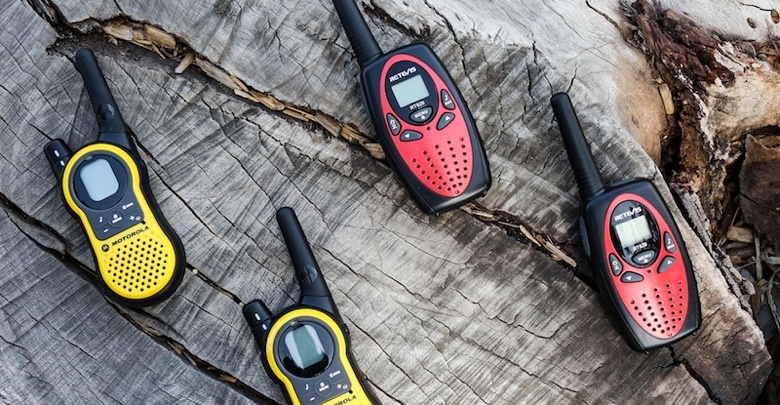In near perfect conditions, the average recreational walkie talkie has a range of 20-30 miles. In real-world conditions with trees, hills and obstacles expect no more than 3 miles. If you’re using the GMRS channels you can get up to 30 miles or more – but this requires a government license in most cases.
If you’ve been researching a walkie talkie to buy lately, you may have read some of the product descriptions which promise 20-40 mile ranges and wondering why reviews or the reports you’ve heard from others never match up to these figures. In this piece, I’m going to uncover why there is such a discrepancy between what brands say and the actual boots on the ground results that you can get.
Why don’t walkie talkies have the advertised range?
The range that manufacturers post tends to be the highest possible range in the most optimistic of conditions – and this is being charitable. It’s almost inconceivable to get the listed ranges (using standard channels) unless you’re in space.
What is the range of walkie talkies in different scenarios?
Depending on where you are in the type of environment radio signals between the walkie talkies behaves in different ways. If it has a straight line of uninterrupted travel then it can carry much further.
The more objects and obstacles you lay between one radio and another the more choppy the signal becomes until there is a point where not enough of the information within the signal can reach the receiver and communication become impossible to decipher. You’ll get the dreaded crackle or radio noise or occasional intermittent words that choppily come through.
Here are some different scenarios and the expected range you would get with the average recreational two-way radio setup.
| Scenario ⛰ | Distance |
| Urban environment like a city | ½ mile |
| Inside a high rise building | 5-10 floors |
| Wooded valley | 1 mile |
| Open valley | 1-3 miles |
| Clear line of sight | 3+ miles |
Does weather affect range?
Yes, generally bad weather like storms, fog or cloud will impact the power of the signal and reduce your range.
The best conditions or bluebird days when the sky’s are clear. Obviously you can’t control the weather, but be aware that the range may be limited in poor conditions and take this into account when you next venture out into the mountains.
How to improve the range?
There are few ways to improve your walkie talkies range without going out and buying a brand new walkie talkie.
Height is your friend
The higher you go, the more you range you’ll get. Surprisingly the curvature of the Earth even on short distances does have a measurable effect on your range.
The curvature is approximately 8 inches per mile or 1 foot every 1.5km (source) which means holding your radio higher and getting just a few feet higher up you’ll notice an increase in your range when using at the edges of its limits.
The higher your can get yourself the more your range will be with all things being equal. A higher range allows to overcome obstacles like trees and buildings and project your signal further across the landscape.
Hold your walkie talkie upright
Although it might seem like a minor issue, the way you hold your walkie talkie has a surprising affect. Because radio is transmitted in horizontal waves perpendicular from the antenna, it’s important to hole your radio in an upright vertical position rather than hold it at angle to your face.
The waves are transmitted omni-directional around you. If you have your radio held on its side or at angle then the distance the signal can project will be noticeable smaller.
Use an antenna extender
By using an extender you can increase your range which you can pickup on Amazon for less than $20. The Retevis two way radio antenna (view on Amazon) comes in a pack of 5 and does a good job of extending your radio – check the compatibility first.
If the extender is compatible, you can unscrew your current antenna and screw in the extender for better range and sharper signal.
Increase the wattage of your walkie talkie
Buying the highest watt walkie talkie won’t necessarily increase the range significantly, but using your radio at its highest wattage is recommended.
If you’re using AA batteries with your radio the battery life will be longer but the wattage is likely to be less and so your range will be less. Using the rechargeable battery that comes with the radio will improve your range and should be used primarily. The AA batteries are good backups if your radio supports these, but won’t offer the best range.
How to prevent chatter?
There are 22 channels in the U.S that can be used by recreationally under the Family Radio Service frequency which is usually more than enough for most situations. Sometimes when the airwaves are crowded these channels are not enough and you can often pickup interference or other peoples radio chatter throughout the day.
Not only can this drain your battery but it can interfere with communication from others in your party. The best way to overcome this is to use privacy codes. Most newer walkie talkies have this feature and it is a subset of 121 channels within the channels that allows you to communicate without interference.
Despite the name others can still listen into your conversations if they want but they can’t communicate with you. More on privacy codes here:
What is the best walkie talkies?
After many hours reviewing the best recreational walkie talkies on the market, my top pick was the Motorola MR350R FRS/GMRS Two-Way Radio (check price on Amazon).

I reviewed this and my other top picks in detail over on my piece: Best Walkie Talkies reviewed.
What is the difference between walkie talkies and two-way radios?
A walkie talkie is a two-way radio, while a two-way radio is not always a walkie talkie.
Walkie talkies and two-way radios are essentially the same thing. If you want a more thorough breakdown check out the comparisons here.
Final thoughts
Walkie talkies range is never as good as advertised because ideal conditions are never found in real life unless you’re on the Utah salt flats or out in the ocean on a clear day.
Expect your walkie talkie range to be 3miles or less and keep this in mind when out hiking with your buddies.





